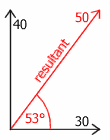FizziCalc
Intermediate
Advanced
Cool Topics
Reference
Search
Games and Fun Stuff
Meeting Forum
Physics Links
Basic Kinematics |
|
Return to the Beginner Level Page.
Remember the ball? Well, basic kinematics will explain how that ball travels when you throw it. Kinematics is a mathematical description of how something moves. It sounds intimidating, but it is not very hard to understand.
Speed and Velocity, Distance and Displacement
Wait, aren't speed and velocity the same thing? What about distance and displacement, aren't they the same too?Both pairs are similar but they are not exactly the same. In order for you to tell the difference you need to learn what vector and scalar quantities are. It is really easy so don't worry.
In physics there are these important things called vectors. A vector is simply something that has magnitude and direction. So let's say you're throwing that same ball from before. You can represent it as a vector because it is going up into the air at an angle (direction) and a certain speed (magnitude).
With vectors, direction matters and it matters a lot. You may throw the ball with the same speed (magnitude), but if you throw it down into the ground (direction), it will not be able to reach your friend across the park.
Just like with regular numbers, you can add vectors together. However, you need to take direction into account. For example, using vector addition, if two vectors point in opposite directions and have the same magnitude, then they cancel each other out. The result of a vector addition is called the resultant vector, or the net vector.
Let's say one vector with magnitude 20 is pointing to the right and another vector with magnitude 10 is pointing to the left. Now add them. What's the resultant vector? The answer is a vector of magnitude 10 pointing right.
 Vector addition applies to all directions, not just left and right.
For example, the resultant vector of a vector with a magnitude of 30 to the right and another with a magnitude of 40 upward is a vector with a magnitude of 50 pointing diagonally at about 53° above the right (see illustration at right).
Vector addition applies to all directions, not just left and right.
For example, the resultant vector of a vector with a magnitude of 30 to the right and another with a magnitude of 40 upward is a vector with a magnitude of 50 pointing diagonally at about 53° above the right (see illustration at right).Speed and distance are both scalars, they have no direction because when you calculate them, direction is not important. Velocity and displacement are both vectors; they have direction, and it is very important. For example, if you walk 1 km east and then walk 1 km west, the distance you traveled is 2 km. However, the displacement is 0 km since it takes direction into account.
Speed is calculated by taking the distance traveled divided by the time traveled. The magnitude of velocity is calculated by taking the displacement made divided by the time traveled.
Let's use an example to explain the differences between the four different things. Your father tells you that he lived about 10 km away from his school and he walked through a blizzard in his bare feet to school and it takes him about 5 hours. So what was the distance he traveled? This is sometimes hard to calculate. If he walked in a straight line, through trees and houses and anything else in the way, it would be 10 km. But the most accurate way to measure it is to connect all of his footprints and measure how long it is. Let's say we connected all the footprints and found out he actually walked 15 km.
So his distance is 15 km...
...and his displacement is 10 km in the direction of his school (note that the direction must be stated for vector quantities, unless it's 0).
Therefore, his speed was 3 km/hr...
...and his velocity was 2 km/hr in the direction of his school.
Then he treks all the way back home from school. Since he ended up back at the place he started, his displacement becomes 0 km. Therefore, his velocity was zero too.
So in the all years of school he has gone too, his velocity has been zero. His displacement was also zero. Now go tell anyone who has given you that story that they actually had a displacement of zero and see how red their face becomes.
Check out the Vector Addition in our games and fun stuff section to see how displacement vectors add together.